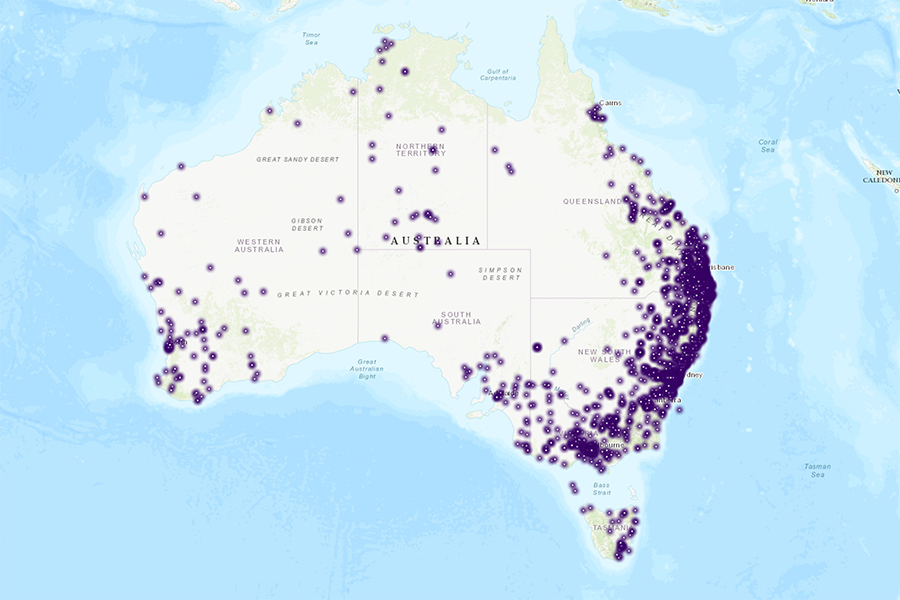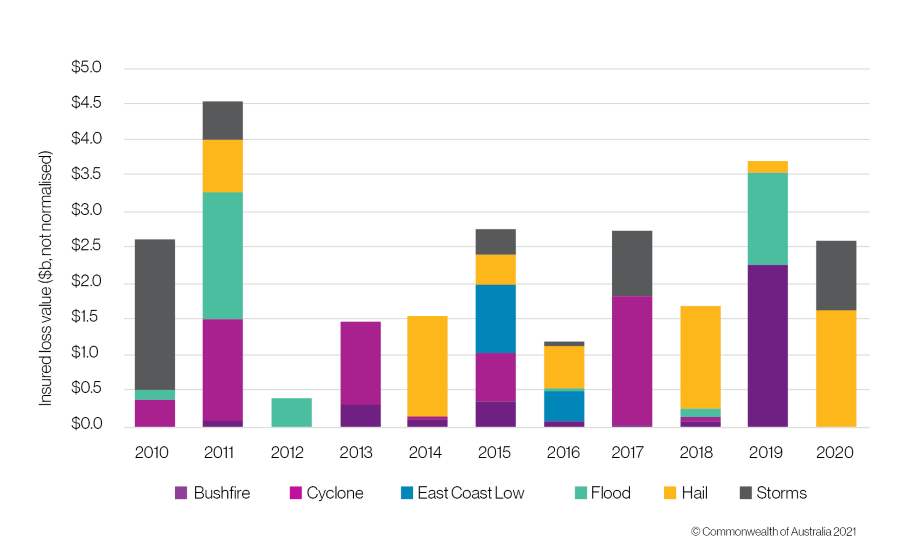What is the costliest natural Hazard in Australia? It’s the damage wrought by hailstorms – and studies show that they are going to increase in severity and frequency1. Do you really understand the risk to your property and business and the steps that need to be taken to minimise the impact?
Hailstorms are responsible for over one-third of the total cost of all insured losses in Australia caused by natural hazards.

Coastal south-eastern Australia, which includes Sydney, Melbourne and Brisbane, contains more than 60% of Australia’s total population. This combination of high-density population and significant insured assets represents a major risk with over 80% of hail losses occurring in NSW alone.
The Bureau of Meteorology (BOM) recorded a total of 2015 hailstorms between January 2000 and December 20202 (Figure 1).
You can see from this chart that the risk presented by the hail peril is high. Seven of the 10 most expensive (inflation-adjusted) storm losses in Australia have occurred within the last 10 years3. This trend of increasingly frequent and more destructive storms is expected to continue.
Understanding the frequency of hailstorms is one part of assessing the hazard posed but knowledge of the damage they can cause is crucial in quantifying the risk.
Figure 2 shows all insured losses caused by natural hazards between 2010 and 2020. During that period, 25% of all insured losses were directly attributed to hail for a total of $6 billion in insured value. Additionally, the largest single insured event in Australian history was the 1999 Sydney hailstorm with a normalised cost (to 2017) of $5.6 billion.

source Royal Commission in National Natural Disaster Arrangements
So why do hailstorms cause so much damage to property? Two main factors contribute to the destructive capacity of a hailstone: size and speed.
The fall speed of hail depends on the size of the hailstone, the friction between it and surrounding air, the local wind conditions (both horizontal and vertical), and its degree of melting.
| Size (mm diameter) | Fall speed range (kmh) |
|---|---|
| Less than 25 | 15-40 |
| 24-45 | 40-65 |
| 50-100 | 70-115 |
| Over 100 | 160+ |
In a severe thunderstorm we typically see hailstone of 25-45mm while the strongest supercells usually produce in the 50-100mm range. Even larger have been recorded.4
Significant damage can occur to glass in particular. The thickness and type of glass used in windows and doors are generally determined by design criteria, performance and building codes. Most residential windows are fitted with clear float glass (i.e. standard glass), with thicknesses ranging from 3-5mm. Doors are generally fitted with 4mm or 5mm clear toughened glass5. Also known as Grade A safety glass, toughened glass is heat treated for extra strength and is five times stronger than standard glass.
Tests show that float glass can be broken by hailstones with a diameter greater than 25mm. The BOM’s Severe Storm Archive shows that more than 60% of all hailstorms feature hailstones of this size or greater. If you have standard glass installed, it can be expected to be damaged in over 60% of all hailstorms.
It is interesting to note that the IEC 61215 Standard6 includes requirements for hail testing where a 25mm ice ball is fired at the glass side of a solar panel to simulate the impact of a hailstone. The ice balls reach speeds of up to 83kmh which is the average wind speed of a Category One tropical cyclone. So, conforming to this standard does not automatically confer protection from hailstorms.
Apart from glass, hailstorms can also damage:
There are several steps that can be taken to minimise the impact of hailstorms on property and business.
Firstly, aim to use glass that is tested to the highest standard possible. For example, Grade A Glass is verified using an enhanced hail test which is performed with a 45mm diameter ice ball (equivalent to the 25mm ice ball used in our earlier example, travelling at a velocity of 110kmh).
As Grade A safety glass is five-times stronger, look to use this type of glass for as many applications (skylights, windows, doors, etc.) as possible. Being able to withstand incidents of 45mm diameter hailstones means the glass can withstand more than 85% of all hailstorms.
Asbestos sheeting should be removed or covered. Not only is the material brittle and easily damaged by hail, the removal and site remediation costs after being damaged are prohibitive.
Roof-mounted equipment is vulnerable. Businesses should undertake a review to understand items that are critical to operations, highly valuable, and/or susceptible to damage from hailstorms. Examples of equipment necessary for production or building operation could include air handling units, water heaters and telecommunications equipment.
Once a comprehensive list of critical equipment and infrastructure across the business has been compiled, a review will identify what can either be relocated or protected.
Motor vehicle sales and storage yards are particularly vulnerable to hailstorms. Netting can greatly reduce the impact as can minimising the amount of inventory that is unprotected.
Similarly, crops such as fruit trees, vines, and other high value foods can be protected using hail-appropriate netting.
Lastly, for highly susceptible locations, such as photovoltaic solar farms, there should be the following active measures in place:
Due to the possibility of water damage occurring later, it is just as important to conduct an audit after a hailstorm to ensure that there are no leaks within buildings.
The science is clear: the risk of hail is increasing in both frequency and severity in Australia. Steps can be taken to protect your property and never has there been such an important time to act on this risk. Hailstones can cause damage to property directly through impact, and they can also lead to water damaging buildings and their contents. Willis Towers Watson engineers can help you understand what exposures your business has and help you protect them.
Willis Towers Watson Risk Engineering Services can assist you in making cost-efficient and effective property loss protection and insurance decisions, to ensure that key assets of the business are protected and risks are mitigated from the outset.
1 https://www.insurancenews.com.au/local/hail-to-be-more-frequent-in-australia-more-severe-worldwide
2 http://www.bom.gov.au/australia/stormarchive/
3 https://www.munichre.com/topics-online/en/climate-change-and-natural-disasters/climate-change/Icy-cricket-balls-from-above.html
4 https://www.nssl.noaa.gov/education/svrwx101/hail/
5 https://www.windowwarehouseqld.com.au/options/window-and-door-options/glass/
6 https://webstore.iec.ch/publication/61345